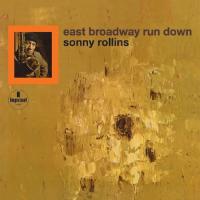Rollins in Quartet With Hubbard and Former Coltrane Rhythm Section
Sonny Rollins sparring with Freddie Hubbard (title tune only) backed by the reunited Coltrane drum’n’bass section of Elvin Jones and Jimmy Garrison sounds like an enticing lineup for this May, 1966 session at Van Gelder’s and it is!
Jones had left Coltrane earlier that year, as had McCoy Tyner, but Garrison remained, uniting again with Jones to back Rollins in this session recorded around the same time Coltrane’s Live At The Village Vanguard Again! was recorded.
The title tune, filling side one, is a long, rumbling, raucous effort that marches and rumbles along supported much of the way by Garrison’s one note pulse and Jones’s percolating tom rolls and splashy cymbal work.
Rollins chews off big hunks of bluesy melody, sometimes sounding like he’s madly leading a cavalry charge and other times (occasionally with the mouthpiece detached!) sounding like squeaky subway wheels negotiating a curve, mostly way behind the beat. He locks up intensely with Hubbard only occasionally, on the piece’s main theme, which the two ride out for tune’s abrupt finale. It’s an oddly (un)structured, yet inviting album side of experimental free jazz that never wears out its welcome and sounds more daring as the years pass.
Side two opens with “Blessing in Disguise,” a tuneful Rollins composition featuring a catchy, riff based on Lionel Hampton’s “Hey Ba Ba Re Bop,” that Rollins burns into your subconscious with juicy, full throated repetitions and a great, loping Garrison solo.
The album concludes with the ballad “We Kiss In A Shadow,” a cover from Rodgers and Hammerstein’s “The King and I,” that’s taken at a ultra-leisurely pace, with Rollins at first spilling the melody with gorgeous, straight-forward lyricism followed by a deconstructed rendering taken at a languid pace, that flutters and drifts off into the ether, ending both the album and Rollins’ recording career for a full six years.
A short, but important album in the Rollins discography, that has a powerful pull and, thanks to the rhythm section, a swagger and weight that doesn’t quit, even after decades of listening.
Van Gelder’s sonics are variable, with side two being richer and fuller than on side one, particularly Rollins’ horn but both sides offer a spacious, vivid mix, with Jones occupying a great deal of right channel real estate, and Rollins left of center. The reissue’s sonics are very, very good, though some atmosphere and top end has clearly faded from the tape over the forty two years since it was recorded. No matter, without an original to compare it to, this Pallas-pressed reissue will satisfy even the pickiest among you.
The 1995 CD (IMPD-161) sounds softer and warmer (yet harder) and loses most of the reverb, while smothering Garrison's attack. What else is new?
- Log in or register to post comments




